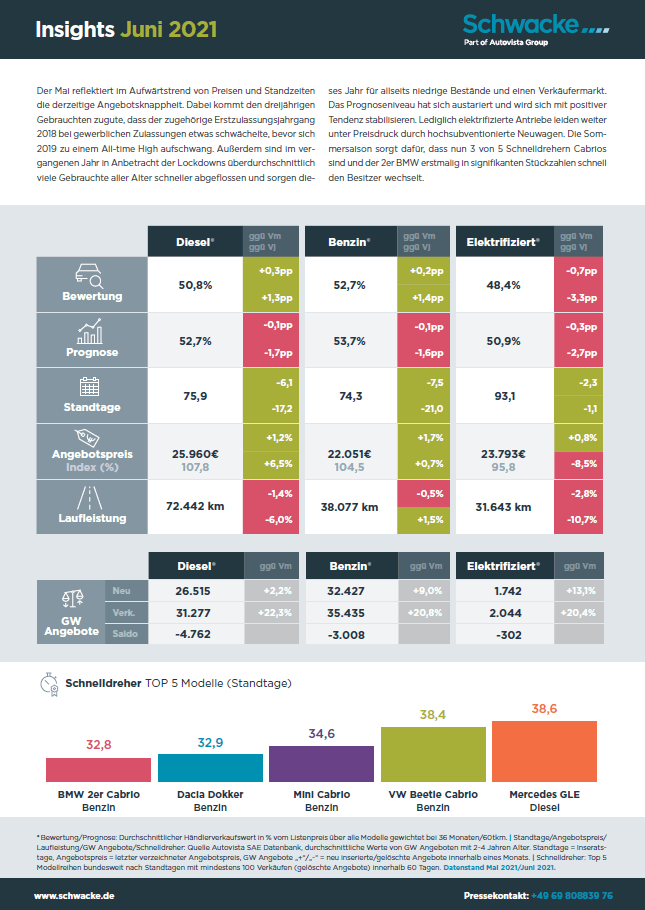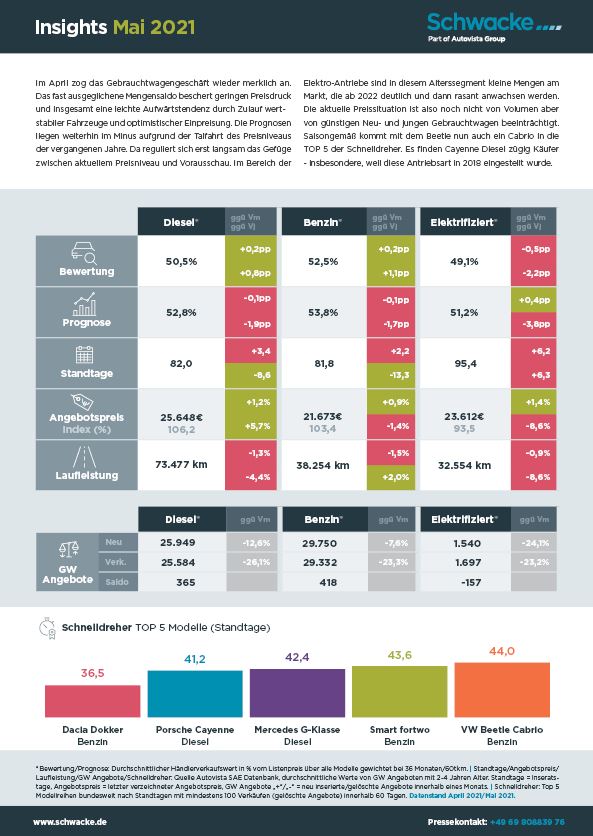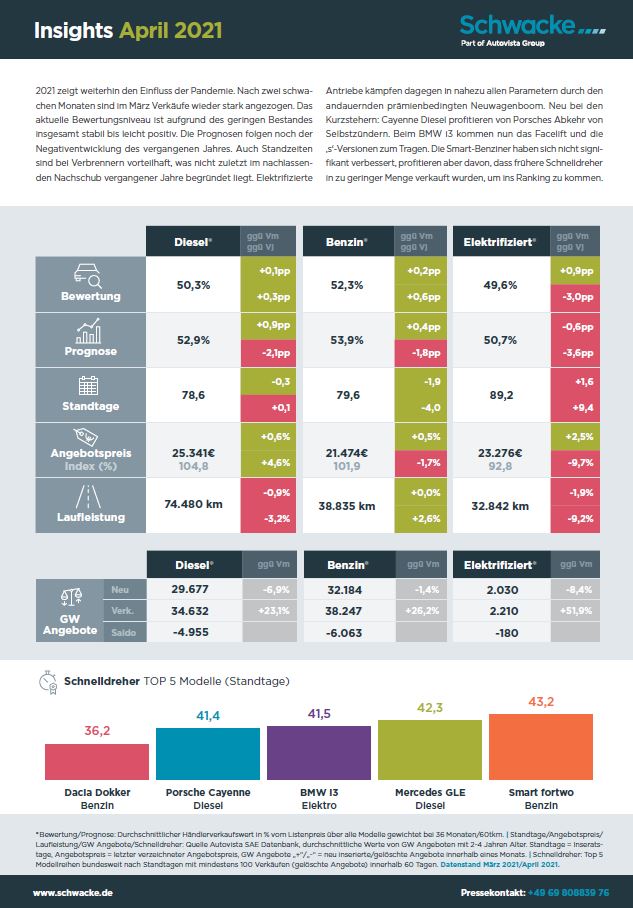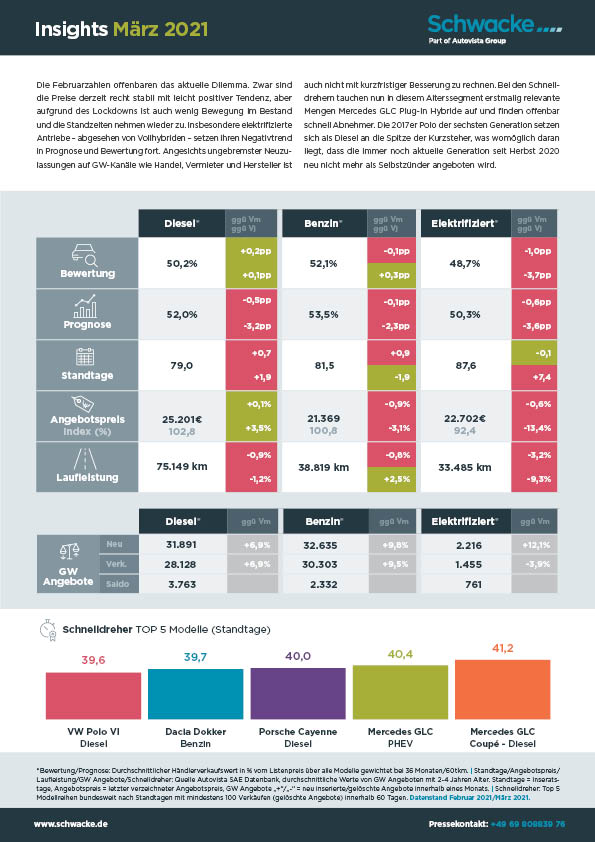Der Mai reflektiert im Aufwärtstrend von Preisen und Standzeiten die derzeitige Angebotsknappheit. Dabei kommt den dreijährigen Gebrauchten zugute, dass der zugehörige Erstzulassungsjahrgang 2018 bei gewerblichen Zulassungen etwas schwächelte, bevor sich 2019 zu einem All-time High aufschwang. Außerdem sind im vergangenen Jahr in Anbetracht der Lockdowns überdurchschnittlich viele Gebrauchte aller Alter schneller abgeflossen und sorgen dieses Jahr für allseits niedrige Bestände und einen Verkäufermarkt. Das Prognoseniveau hat sich austariert und wird sich mit positiver Tendenz stabilisieren. Lediglich elektrifizierte Antriebe leiden weiter unter Preisdruck durch hochsubventionierte Neuwagen. Die Sommersaison sorgt dafür, dass nun 3 von 5 Schnelldrehern Cabrios sind und der 2er BMW erstmalig in signifikanten Stückzahlen schnell den Besitzer wechselt.
Fuel Type: Vollhybrid (HEV)
Carmakers successfully pooled emissions to meet 2020 EU targets
Autovista Group senior data journalist Neil King investigates the emissions performance of major carmakers in the EU in 2020. In this first part, King discusses pooling and focuses on manufacturers that successfully spread their emissions over a larger fleet average.
The issue of CO2 targets has given many carmakers a headache in recent years. Until 2016, many relied on diesel engines to help them achieve their goals. Yet, the collapse in trust and sales of this technology left manufacturers scrambling for alternatives, especially as consumers switched to the higher CO2-emitting petrol cars and SUVs.
The best option was to push ahead with plans for both hybrid and electrically-chargeable vehicles (EVs). Some carmakers were more advanced in developing these technologies, which led to several manufacturers combining their fleets into pools, spreading out CO2-emission figures over a larger area and reducing the chances of a fine.
Manufacturers established a number of pools to help meet their 2020 and 2021 targets, and all but one was successful last year. Volkswagen Group, part of the biggest pool by market share, missed its projection by a small margin, just 0.5g. However, every carmaker managed to reduce their average fleet emissions, compared to 2019.
Running the numbers
From 2021, the average emissions target for new cars registered in the EU is set at 95g/km CO2. For every 1g/km of CO2 a manufacturer exceeds its average emissions target by, it is fined €95, multiplied by its volume of new-car registrations in the preceding year.
However, the highest-polluting 5% of new cars registered in 2020 are excluded from the 2021 fines calculations, which serves as a transitional phase for carmakers. Based on analysis of data distribution, Autovista Group calculates that this reduced average CO2-emissions figures by about 7%. From 2022 onwards, however, full compliance of all new cars is required (i.e. new cars registered in 2021 onwards).
Pool party
The idea of a pool is simple. A carmaker struggling to meet targets reaches out for help to those who are more successfully managing their CO2 output. Once in the pool, both sets of emissions figures are combined and spread out over an expanded fleet, reducing the average and, in most cases, helping the struggling company achieve its target and avoid a fine. The compliant manufacturer will likely receive financial compensation for its help.

Of all the major manufacturers in Europe, Toyota was in the strongest position to meet its emissions target in 2020. Compared to their 2017 level, the Japanese group only had to reduce their average fleet emissions by 9g CO2/km (9%). The manufacturer has not revealed detailed emissions figures but has confirmed it met its target, supported by strong demand for its hybrid-electric vehicles. Therefore, the OEM was able to help fellow Japanese manufacturer Mazda, which only launched its first BEV, the MX-30, in 2020.
Similarly, Renault, Nissan and Mitsubishi pooled their emissions. The Renault Group itself benefitted from the Zoe BEV and its extended range of E-Tech hybrid and plug-in hybrid (PHEV) variants of models such as the Clio, Captur and Megane. Nissan’s fleet-average emissions were aided by the Leaf BEV and, combined, Renault-Nissan was only 2g/km short of its target in the first half of 2020.
In order to comply with European emissions targets going forward, Mitsubishi Motors will source models from Renault that meet regulatory requirements. ‘Starting 2023, Mitsubishi Motors will sell two “sister models” produced in Groupe Renault plants, which are based on the same platforms but with differentiations, reflecting the Mitsubishi brand’s DNA,’ Renault revealed.
Recall issues
As an example of the fine lines that manufacturers walk to meet their emissions targets, Ford was forced to consider pooling towards the end of 2020. The carmaker issued a recall of its Kuga plug-in hybrid (PHEV) in August of last year. As the carmaker did not have a battery-electric vehicle (BEV) in its fleet, it was heavily reliant on the PHEV to lower CO2 levels.
Ford had already faced a higher mountain to climb, with its 2017 emissions figures showing it needed to reduce CO2 output across its fleet by 26g/km (21%). The recall led the manufacturer to announce it was considering pooling, in order to meet its targets.
‘The current issues with the Kuga PHEV, resulting in a stop-ship and stop-sale have affected our plan to meet the EU’s 2020 emissions regulations for passenger vehicles on our own,’ Ford said to Autovista Group at the time. ‘Therefore, just as many other OEMs have done in Europe, we now intend to join an open pool with other OEMs for passenger vehicles.’
Ford entered into an agreement with Volvo in November. Although the US carmaker has not provided detailed figures, it did meet its 2020 target, likely thanks to this pool.
Sought after
Fiat Chrysler Automobiles (FCA) faced the biggest challenge to comply with European emissions targets. The US-Italian group needed to lower their emissions by 29g/km (24%) compared to 2017 levels. This largely explains why FCA pooled its emissions figures with US BEV manufacturer Tesla.
The move brought FCA’s average CO2 emissions down by offsetting the company’s petrol and diesel vehicles from Fiat, Jeep, Alfa Romeo and Maserati against the zero-emission outputs of Tesla’s BEVs. CEO Mike Manley already suggested in August 2019 that the Italian carmaker would be compliant because of the regulatory credit deal with Tesla. Honda was subsequently brought into this pool too.
Tesla is the largest BEV-only carmaker in Europe, having entered the market in 2008 with its limited production Roadster, before launching its first BEV sedan, the Model S, in 2012. The manufacturer built up a base of BEV models while other carmakers continued to promote ICE and was well-placed to capitalise when consumers started considering alternative options. Therefore, its CO2 credits would provide a good opportunity for carmakers to reduce their overall levels. While the US company sells fewer vehicles than bigger players in the automotive market, average emissions across its entire fleet will be no higher than zero.
The FCA annual report states that CO2 emissions data for last year is not yet available but: ‘the 2020 result is expected to move toward the 95g CO2/km EU average target due to the adoption of a multi-faceted approach which leveraged conventional technologies, high-voltage electrification, pooling arrangement contribution and compliance rules for 2020.’
‘The quantity of CO2 emissions in 2021 will be affected not only by market evolution (such as the expected reduction of diesel market share) but also by the commercialisation of low-emission and electrified vehicles. Finally, according to applicable EU regulations, current pooling arrangements for emissions compliance for passenger cars entered into by FCA are expected to apply in 2021,’ FCA added.
However, at the start of 2021, FCA merged with PSA Group to form Stellantis. CEO of the new manufacturing group, Carlos Tavares, has since been reported to have terminated the agreement with Tesla. As PSA Group met its emission targets in 2020, and as FCA’s figures will now merge with these, the company should be in a position to achieve its CO2 goals at the end of this year.
In the next instalments of this series, Neil King will explore those manufacturers who met their emissions targets on their own and carmakers who failed to reduce CO2 sufficiently, whether they pooled or not.
Schwacke Insights Mai 2021 – monatliche Kennzahlen im Überblick
Im April zog das Gebrauchtwagengeschäft wieder merklich an. Das fast ausgeglichene Mengensaldo beschert geringen Preisdruck und insgesamt eine leichte Aufwärtstendenz durch Zulauf wertstabiler
Fahrzeuge und optimistischer Einpreisung. Die Prognosen liegen weiterhin im Minus aufgrund der Talfahrt des Preisniveaus der vergangenen Jahre. Da reguliert sich erst langsam das Gefüge zwischen aktuellem Preisniveau und Vorausschau. Im Bereich der Elektro-Antriebe sind in diesem Alterssegment kleine Mengen am Markt, die ab 2022 deutlich und dann rasant anwachsen werden. Die aktuelle Preissituation ist also noch nicht von Volumen aber von günstigen Neu- und jungen Gebrauchtwagen beeinträchtigt. Saisongemäß kommt mit dem Beetle nun auch ein Cabrio in die TOP 5 der Schnelldreher. Es finden Cayenne Diesel zügig Käufer – insbesondere, weil diese Antriebsart in 2018 eingestellt wurde.
Schwacke Insights April 2021 – monatliche Kennzahlen im Überblick
2021 zeigt weiterhin den Einfluss der Pandemie. Nach zwei schwachen Monaten sind im März Verkäufe wieder stark angezogen. Das aktuelle Bewertungsniveau ist aufgrund des geringen Bestandes insgesamt stabil bis leicht positiv. Die Prognosen folgen noch der Negativentwicklung des vergangenen Jahres. Auch Standzeiten sind bei Verbrennern vorteilhaft, was nicht zuletzt im nachlassenden Nachschub vergangener Jahre begründet liegt. Elektrifizierte Antriebe kämpfen dagegen in nahezu allen Parametern durch den andauernden prämienbedingten Neuwagenboom. Neu bei den Kurzstehern: Cayenne Diesel profitieren von Porsches Abkehr von Selbstzündern. Beim BMW i3 kommt nun das Facelift und die ‚s‘-Versionen zum Tragen. Die Smart-Benziner haben sich nicht signifikant verbessert, profitieren aber davon, dass frühere Schnelldreher in zu geringer Menge verkauft wurden, um ins Ranking zu kommen.
Making the CASE for advanced commercial vehicles
Advanced automotive systems including connected cars, autonomous driving, shared vehicles, and electromobility (CASE), are experiencing exponential development as OEMs undergo digitalisation. While many of these technologies might be associated with high-end luxury passenger cars, manufacturers are also exploring commercial vehicle applications.
Toyota Motor Corporation (Toyota) recently announced it would combine its CASE technologies with the commercial vehicle foundations cultivated by Isuzu Motors (Isuzu) and Hino Motors (Hino) as part of a new collaborative effort. Meanwhile, Renault’s light commercial vehicle (LCV) offering is undergoing its own energy transition, emphasising electric and hydrogen drivetrains for its upcoming models.
A commercial CASE
Through their new partnership, Toyota, Isuzu and Hino hope to accelerate the adoption and implementation of CASE technologies. As well as addressing various difficulties facing the transport industry, the three companies hope their collaboration will help the progression towards a carbon-neutral society.
In a press conference, the manufacturers explained small commercial-purpose trucks would be used to help develop battery electric vehicles (BEVs), electric platforms, and fuel-cell electric vehicles (FCEVs). Given the expensive developmental costs of BEVs and FCEVs, this collective approach makes sense. Toyota, Isuzu and Hino are also planning to advance the implementation of infrastructure. This will include introducing FCEV trucks to hydrogen-based society demonstrations in Japan’s Fukushima Prefecture.
The partnership will also look to accelerate the development of autonomous and other advanced systems. By building a connected technology platform for commercial vehicles, they hope to provide logistical solutions to improve transport efficiency as well as reducing CO2 emissions.
‘CASE technologies can only contribute to society once they become widespread,’ the companies explained. ‘Commercial vehicles can play important roles in dissemination, as they travel long distances for extended periods of time to support the economy and society and can be easily linked with infrastructure development. And from the standpoint of carbon neutrality, commercial vehicles can especially fulfil a key function.’
Forming new ties
To promote the partnership, the manufacturers will form a new business called Commercial Japan Partnership Technologies Corporation. This new company will be focused on mapping out CASE technologies and services for commercial vehicles. Moving forward, the collaboration will not only deepen, but open up to other like-minded partners.
Isuzu and Toyota have also agreed on a capital partnership to advance their collaborative efforts. Through a cancelation of treasury stock through a third-party allotment, Toyota is scheduled to acquire 39 million shares of its common stock worth a total of ¥42.8 billion (€332 million).
This will leave Toyota with 4.6% ownership of Isuzu in terms of total issued shares as of the end of September 2020 and a post-allotment voting rights ratio at Isuzu of 5.02%. Isuzu also plans to acquire Toyota shares of the same value through a market purchase.
Renault’s zero-emission solutions
Meanwhile, Renault is renewing and expanding its LCV range, with new versions of the Kangoo, the Express, the Trafic Combi and the SpaceClass. The manufacturer is also developing its Renault Pro+ services, offering turnkey digital and connectivity solutions.
Through this work Renault is looking to support the transmission to zero-emissions. The new Kangoo Van E-TECH Electric is expected by the end of 2021, picking up where the Kangoo ZE left off. It will be equipped with a 44kWh battery, offering a range of 265km. The OEM also offers fleet charging solutions with its subsidiary, Elexent.
Before the end of the year, Renault will unveil the Master ZE Hydrogen, an alternative to the diesel Master. With its hydrogen partner Plug Power, the manufacturer is looking to capture 30% of the European hydrogen LCV market by 2030.
Smart zero-emission vans promise greater development of green and connected technology for the wider automotive sector. Commercial vehicles spend their lives on the road, meaning any new drivetrain and technology must be well-designed and long-lasting. This know-how can then be utilised by the passenger-car segment, as these systems are stress-tested.
However, these technologies must first be adopted. As demonstrated by the European Automobile Manufacturer Association’s (ACEA’s) latest figures, diesel still reigned supreme last year in the new-LCV segment. Accounting for 92.4% of the van market, the fuel type was leagues ahead of electrically-chargeable vehicles (EVs) which garnered a 2% share. In reality, the adoption of these new drive trains will likely be mandated by zero-emissions policies created at national and international levels.
Schwacke Insights März 2021 – monatliche Kennzahlen im Überblick
Die Februarzahlen offenbaren das aktuelle Dilemma. Zwar sind die Preise derzeit recht stabil mit leicht positiver Tendenz, aber aufgrund des Lockdowns ist auch wenig Bewegung im Bestand und die Standzeiten nehmen wieder zu. Insbesondere elektrifizierte Antriebe – abgesehen von Vollhybriden – setzen ihren Negativtrend in Prognose und Bewertung fort. Angesichts ungebremster Neuzulassungen auf GW-Kanäle wie Handel, Vermieter und Hersteller ist auch nicht mit kurzfristiger Besserung zu rechnen. Bei den Schnelldrehern tauchen nun in diesem Alterssegment erstmalig relevante Mengen Mercedes GLC Plug-In Hybride auf und finden offenbar schnell Abnehmer. Die 2017er Polo der sechsten Generation setzen sich als Diesel an die Spitze der Kurzsteher, was womöglich daran liegt, dass die immer noch aktuelle Generation seit Herbst 2020 neu nicht mehr als Selbstzünder angeboten wird.
Video: Europe’s registrations struggle in February but improvements to come
Autovista Group Daily Brief editor Phil Curry discusses the registration figures from Europe’s big five automotive markets. While numbers may be down, the outlook for the whole year is more positive…
To get notifications for all the latest videos, you can subscribe for free to the Autovista Group Daily Brief YouTube channel.
Show notes
Lockdown drives German new-car registrations down by 19% in February
February UK new-car registrations plunge to level of 1959
Significant downturns in European registrations in February
Podcast: How is European automotive adapting to pandemic and climate-change fallout?
Daily Brief editor Phil Curry and journalist Tom Geggus discuss key activities and developments in the European automotive sector from the past fortnight. These include COVID-19’s effect on the uptake of mobility-as-a-service (MAAS), different fuel types, and autonomous technology.
Show notes
Cazoo buys Cluno as CaaS options increase
Significant downturns in European registrations in February
Lockdown drives German new-car registrations down by 19% in February
February UK new-car registrations plunge to level of 1959
VW accelerates towards electric and digital future
VW aims for commercialised autonomous systems in 2025
Is it too early to go ‘EV-only’?
Ford to be zero-emission capable in Europe by 2026
Jaguar makes BEV and hydrogen changes on path to net zero
The remarketing risk of EVs
The remarketing of electrically-chargeable vehicles (EVs) is examined by Autovista Group experts in our latest webinar. The mixed approach across Europe to provide stimuli for EV sales is paying off, with forecasters predicting a 40% market share for the technology by 2030. Does the increase in registrations trigger new remarketing risks? The panel considers whether the increasing sales of EVs will impact RV performance over the next three years. It also looks at potential differences in risk between BEV and plug-in hybrids (PHEVs).
You can view the entire webinar below, or download the slide deck here.
Autovista Group will be running a number of webinars looking at automotive trends this year. To be notified of upcoming events, subscribe to the Autovista Group Daily Brief.
Schwacke Insights Februar 2021 – monatliche Kennzahlen im Überblick
Der Jahresauftakt wurde durch den Lockdown gründlich verhagelt. Zwar sind die Inseratslöschungen leicht gegenüber dem Vormonat gestiegen, aber dies hat technische Gründe. Die verkauften Mengen sind deutlich unter Vormonat und -jahr. Die Prognose folgt dem stetigen Abfall des Bewertungsniveaus und zeigt besonders für Elektrifizierte weiter hohen Druck. Unterdessen zeigen die Bewertungen von Benziner und Diesel leicht positive Tendenz, was die Prognose stabilisieren wird. Die Standzeiten wuchsen durch geschlossene Betriebe weiter an und lassen die Schere zwischen Elektrisch und Verbrenner weit offen. Bei den Schnelldrehern wird sichtbar, dass gebrauchte dreijährige Diesel in der Pandemie teils zur Mangelware wurden und entsprechend zügig Absatz finden. Der Handel hofft nun auf ein baldiges Lockdown-Ende, stehen doch die so wichtigen GW-Monate März bis Mai bevor!
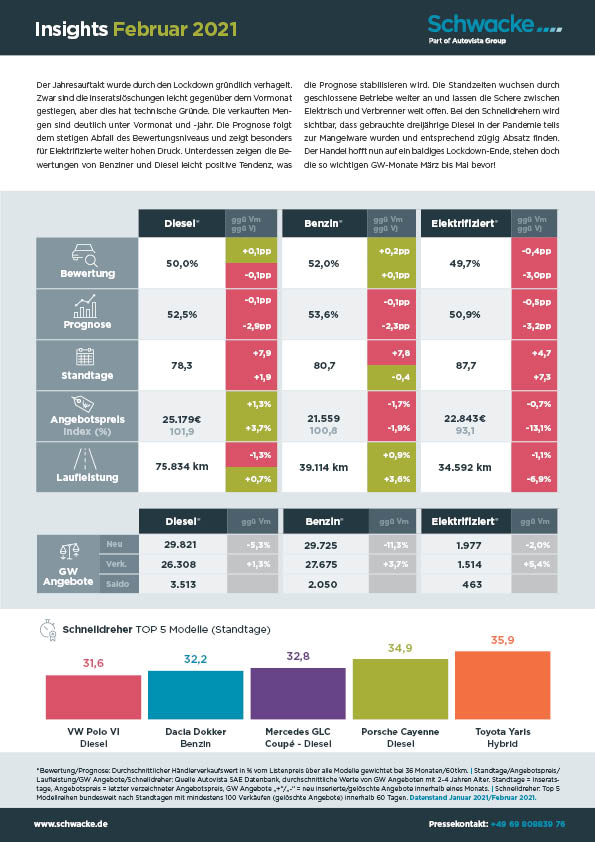
Launch Report: Hyundai Tucson – bolder and roomier
The new Hyundai Tucson has an assertive and bold design, with its front face combining the headlights and grille. The 3D rear-light signature echoes the progressive triangular headlight design and two-tone colour personalisation is now possible. As the new Tucson is longer and wider, it is roomier and more practical than its predecessor and has a large boot.
The modern and refined digital cockpit, featuring a flush-fitting 10-inch screen, is standard across the range and there is also a digital TFT screen directly in front of the driver. The materials, trim and build quality are all good and there are numerous ADAS and safety features, including a central airbag between the two front seats. A neat touch is the blind-spot monitoring system, which shows a digital feed from the left or right side of the car, depending on which direction is indicated.
The Tucson is offered with mild-hybrid (MHEV) petrol and diesel engines or as a full hybrid-electric vehicle (HEV), and a plug-in hybrid (PHEV) version will be available too. The trim lines are well composed and there are relatively few options, leading to well-equipped used cars.
With the leap forward in quality and roominess compared to its predecessor, the Tucson has the potential to attract a wider selection of consumers. The HEV version may present an attractive business proposition for buyers who are not yet ready to plug in.
Click here or on the image below to read Autovista Group’s benchmarking of the Hyundai Tucson in France, Germany and the UK. The interactive launch report presents new prices, forecast residual values and SWOT (strengths, weaknesses, opportunities and threats) analysis.
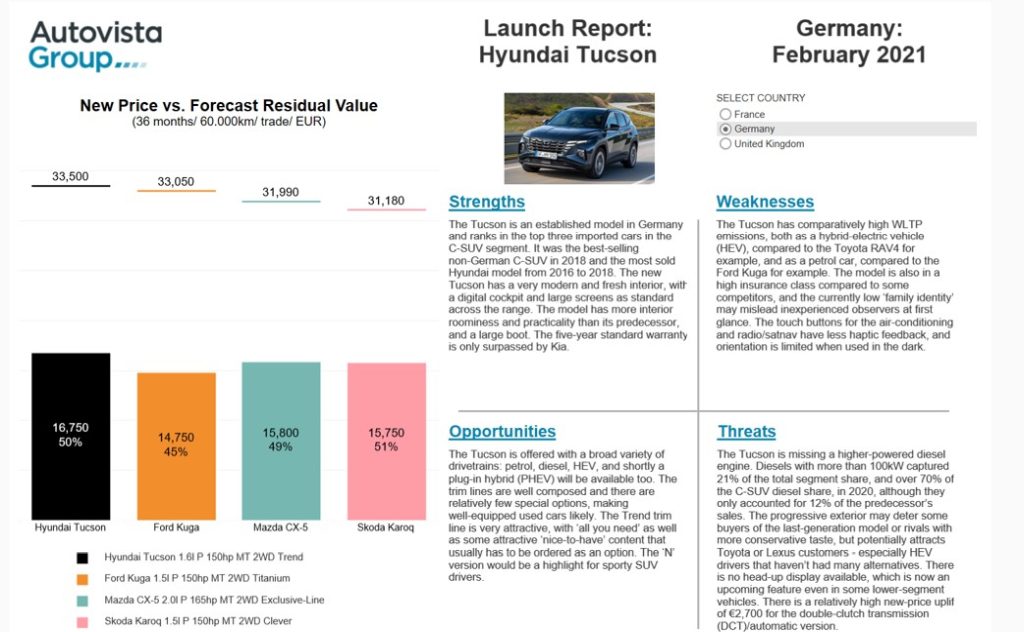
Daimler to become Mercedes-Benz as it spins off truck business
Daimler is to undergo a fundamental change in its structure, spinning off its trucks business and renaming itself Mercedes-Benz. The move is intended to help the company unlock the full potential of its business in a zero-emission future.
Daimler Truck will become a listed company with a majority stake distributed to Daimler shareholders. Mercedes-Benz will continue to develop models for both the passenger car and van markets. Diverging the business will allow each unit to focus on new technologies that are impacting their respective sectors.
Signs of a shift in policy emerged last year when Daimler announced it was developing hydrogen systems for its trucks business while cancelling plans for fuel-cell-powered cars. As the commercial and car markets are likely to take different paths towards zero-emissions, each company will now be able to put funding and resources into its own development rather than share the pot and restrict development as a result. The split is expected to occur at the end of this year, with an extra-ordinary shareholder meeting in Q3 to discuss the final plans and obtain approval.
Corporate structure
‘This is a historic moment for Daimler. It represents the start of a profound reshaping of the company. Mercedes-Benz Cars & Vans and Daimler Trucks & Buses are different businesses with specific customer groups, technology paths and capital needs.’ said Ola Källenius, chairman of the board of management of Daimler and Mercedes-Benz.
‘Both companies operate in industries that are facing major technological and structural changes. Given this context, we believe they will be able to operate most effectively as independent entities, equipped with strong net liquidity and free from the constraints of a conglomerate structure,’ he added.
As part of a more focused corporate structure, both Mercedes-Benz and Daimler Truck will be supported by dedicated captive financial and mobility service entities. The company plans to assign resources and teams from its current Daimler Mobility business to both brands.
‘We have confidence in the financial and operational strength of our two vehicle divisions. And we are convinced that independent management and governance will allow them to operate even faster, invest more ambitiously, target growth and cooperation, and thus be significantly more agile and competitive,’ commented Källenius.
Sustainability needs
Daimler had been struggling in recent years, announcing a series of profit warnings and initially struggling with its CO2 targets following the introduction of the Worldwide Harmonised Light-Vehicle Test Procedure (WLTP). Last year, the company managed to turn things around, tripling sales of plug-in hybrid (PHEV) and battery-electric (BEV) vehicles, and forecasting that it met its emissions figures to avoid any EU-sanctioned penalties.
‘We will continue to push forward with our ’Electric first’ strategy and the further expansion of our electric model initiative. Based on our current knowledge, we expect to meet the CO2 targets in Europe again in 2021,’ said Källenius.
With separate CO2 targets for passenger cars and trucks, Daimler will be keen to keep up this momentum, especially with stricter EU regulations for 2025 and 2030. Therefore, separating its trucks business will give Mercedes-Benz more focus on ensuring it meets guidelines by focusing on its electrification plans.
Further strategy
In October, Daimler unveiled a raft of plans that would see Mercedes-Benz focus on the luxury market with a shift to electrically-chargeable vehicles (EVs). The company plans for the number of internal combustion engine (ICE) models it offers to drop 70% by 2030. Part of this plan could see its range of compact models decrease as it focuses its product portfolio on the most profitable parts of the market.
‘We intend to build the world’s most desirable cars,’ said Källenius at the time. ‘It is about leveraging our strengths as a luxury brand to grow economic value and enhancing the mix and positioning of our product portfolio. We will unlock the full potential of our unique sub-brands – AMG, Maybach, G and EQ. Our strategy is designed to avoid non-core activities to focus on winning where it matters: dedicated electric vehicles and proprietary car software. We will take action on structural costs, target strong and sustained profitability.’
By divesting itself of Daimler Trucks, the carmaker can now focus on expanding new technologies in the passenger car market, including expanding its EQ line-up of BEVs. It plans to increase its range in the shortest space of time, meaning product development resources and expertise will be shifted to electric-drive projects.
Germany: new-car registrations down 31% in January
New-car registrations fell by 31.1% in Germany during January compared with the same month in 2020. A total of 169,754 passenger cars were registered according to the latest figures from the country’s automotive authority, the Kraftfahrt-Bundesamt (KBA).
This aligns with the Autovista Group expectation of a return to year-on-year declines of about 30% in countries where dealers were closed for physical sales. Germany is the largest European market affected in January, with the restrictions currently in place until 14 February.
The German market was also hampered by the return to a 19% VAT rate since 1 January 2021, which had been reduced to 16% from 1 July to 31 December 2020. Autovista Group estimates that this change advanced about 40,000 new-car registrations into December 2020, when the market rose 9.9% compared to the previous reporting period. Furthermore, the shortage of semiconductors will have invariably disrupted some new cars’ deliveries in the country last month.
New-car registrations, Germany, y-o-y % change, January 2020 to January 2021
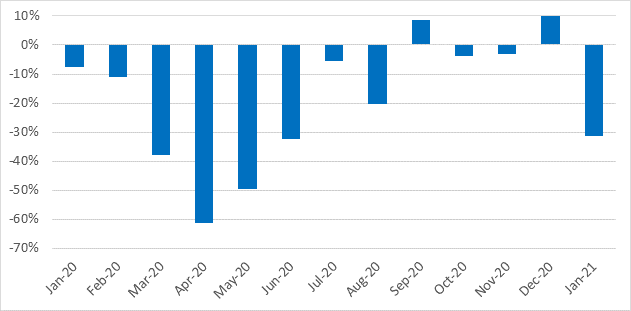
Source: KBA
There were two fewer working days in January 2021 than in January last year. On a comparable working-day basis, Autovista Group estimates that registrations fell by about 23% in the last month, and annualised new-car demand was at 2.94 million units. As in France, Spain and Italy, the start to 2021 of Germany’s new-car market has been deceptively shaky.
Given the mitigating factors in January, this bodes relatively well for the German market, which Autovista Group currently forecasts will recover to 3.15 million units in 2021, 8% up on 2020. This is at the same level as the German automotive industry association VDA forecasts. However, the VDA rightly highlighted that 2021 will still be ‘significantly lower than the approximately 3.5 million new registrations of the years 2017 to 2019.’
‘We assume that the second half of 2021 will bring an improvement, if the progress in vaccination is so great that the pandemic can be noticeably contained in everyday life,’ commented VDA president Hildegard Müller. This echoes the EU-wide sentiment expressed by the European Automobile Manufacturers’ Association (ACEA). ‘The year 2021 will decide the future of the industry in Germany and Europe. We are at a turning point that will set the direction for the following decades,’ Müller added.
Brands and segments
German brands reflected January’s negative performance. Audi (down 47.4%), Mini (down 41.5%), and Ford (down 41.1%) saw the most significant declines. Meanwhile, Porsche posted the smallest losses, with a drop of 3.9%. Volkswagen maintained the largest market share, of 20.1%.
Among the imported brands, Tesla and Volvo exceeded their registration results for the same reporting period in 2020, up 23.4% and 9.4% respectively. In contrast, declines of more than 70% were seen at Jaguar and Honda (down 77.9% and 70.1% respectively), while Fiat recorded the smallest decrease of 14.8%. Skoda was the strongest imported brand for market share, with 6.7% of registrations.
Motorhomes were the only segment to achieve growth, of 5%, to capture a market share of 1.9%. Meanwhile, small MPVs saw the most severe decline at 63.6%, and full-size MPVs fell 55.3%, sports cars slumped by 43.2% and utility vehicles dropped by 42%. SUVs were the strongest segment with 21.9% of the market, despite a decrease of 26.4%, followed by the compact segment with a 19.1% share, down 32.2%.
Fuel types
Registrations of petrol-powered cars fell by half (50.3%) in January 2021 compared to the previous reporting period, taking 37.1% of the market. Diesel also dropped by 44.8%, representing just over a quarter of new cars (26.1%). In contrast, electrically-chargeable vehicles (EVs) saw year-on-year growth of 117.8%, with a total of 16,315 new units registered, taking their share to 9.6%.
Some 45,449 hybrids were registered in January, up 47.5%, while securing 26.8% of the market. A total of 20,588 plug-in hybrid units were registered in January, up 138.3%, with a 12.1% share. Natural gas (259) and liquefied gas (340) only accounted for 0.2% of the market last month, recording a combined decrease of 35.5%. The average CO2 emissions of newly registered cars was 125.9 g/km, representing a decrease of 16.9%.
The tipping balance towards EVs, and away from internal combustion engines (ICE), follows on from a trend recorded last year. In 2020, alternative drives made up of hybrid, fuel-cell, gas, hydrogen, and battery-electric vehicles (BEVs), claimed approximately a quarter of all new-car registrations. The German government set out COVID-19 recovery plans as a springboard towards a greener economy, with a greater emphasis on electromobility. In November, it committed a €4 billion stimulus package to the automotive sector, with funds channelled into the adaptation of production lines and incentivising the purchase of EVs.
Schwacke Insights Januar 2021 – monatliche Kennzahlen im Überblick
Am Jahresende zeigt sich ein stabiles Bild in der Preisentwicklung. Bewertung und Prognose liegen gegenüber dem Vormonat nur geringfügig darunter und Standzeiten sind überwiegend rückläufig. Im Vergleich zum Dezember 2019 hat sich allerdings die Prognose durch den stetigen Preisdruck des Jahres deutlich verschlechtert. Die Aufhellung in der Bewertung der Elektrifizierten ist den Vollhybriden geschuldet, die unbelastet von Prämien und Übermengen, mit positiver Tendenz liefen. Üblich für ein Jahresende sind die anwachsenden Bestandsmengen, auch wenn sie aktuell die Preise nicht signifikant drücken. Der Jahresstart wird optimistisch und einige Händler passen Preise wegen der Mehrwertsteuererhöhung nach oben an. Angebotspreise steigen damit, wenn auch der Nettoertrag bleibt. Bei den Schnelldrehern finden sich die ersten drei- und vierjährigen Polo VI Diesel mit zügigem Abverkauf.
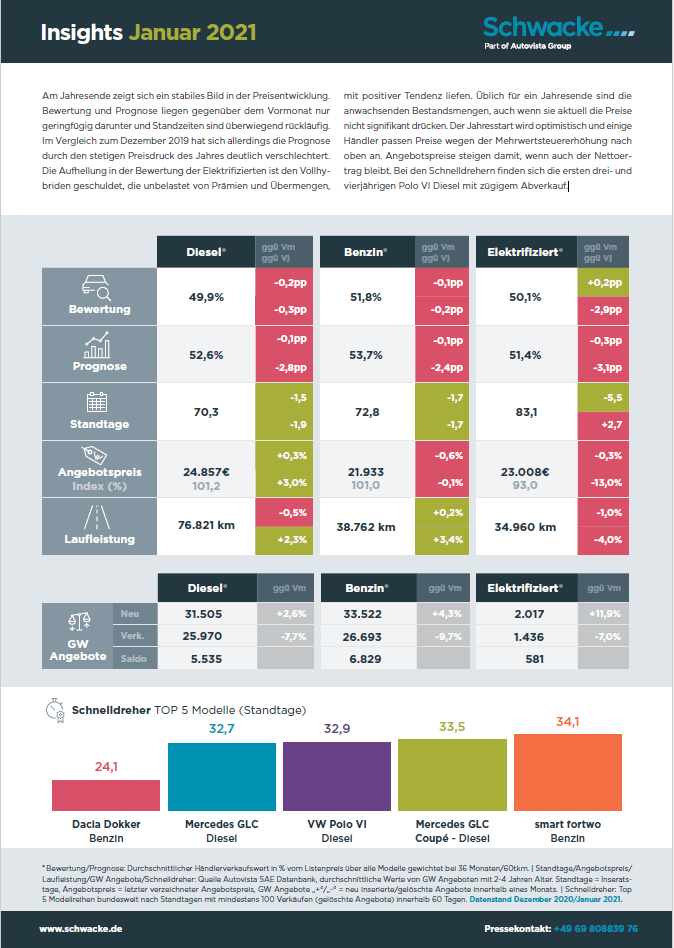
German new-car registrations down 19% in 2020
Germany saw the registration of 2.9 million new cars in 2020, down 19.1% on 2019. The latest figures from the Kraftfahrt-Bundesamt (KBA) show that 62.8% of these units were registered for commercial purposes, down 22.4%, while 37.1% of the market share was private, down 13%.
Bidding farewell to a year of unprecedented challenges, the German market was able to end 2020 on a marginally positive note. A total of 311,394 passenger cars were sold in December last year, up 9.9% on the same period from 2019. Accompanied by an 8.4% rise in September, the German new-car market only saw two months of registration growth in 2020. These upticks in the second half of last year represent a move away from the 61% plunge in April and 49.5% drop in May.
New-car registrations, Germany, y-o-y % change, January to December 2020
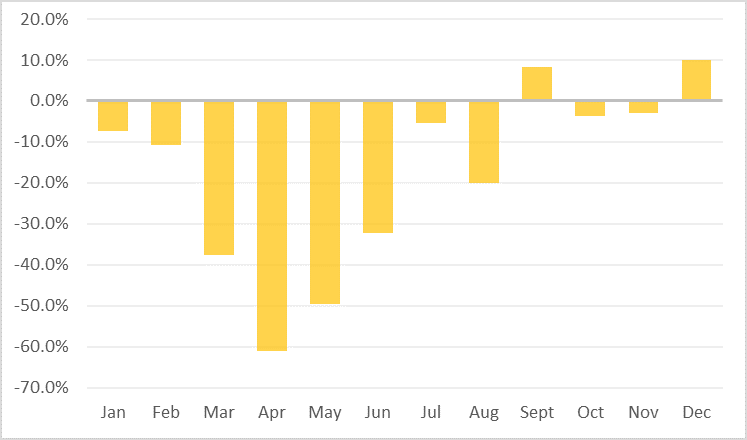
While Germany appears to be leading the way with a recovering automotive market, difficulties continue across Europe as member states are battered by fresh pandemic waves. In December last year, French new-car registrations dropped by 11.8% compared to the same period in 2019. Italy felt a greater decline at 14.9%, while Spain saw just 13 fewer registered units than December 2019. However, Germany does not appear to be out of the woods yet.
Climbing infection rates have triggered an extension of the country’s lockdown measures until the end of January. This makes a positive start to this year seem even less likely as dealerships must remain closed, except for the service departments. While Autovista Group’s Schwacke expects to see a recovery to just under 3.1 million new-car registrations in 2021, it predicts figures will be below those in previous years, and significantly below 2019’s peak.
New-car registrations, EU4, y-o-y % change, January to December 2020
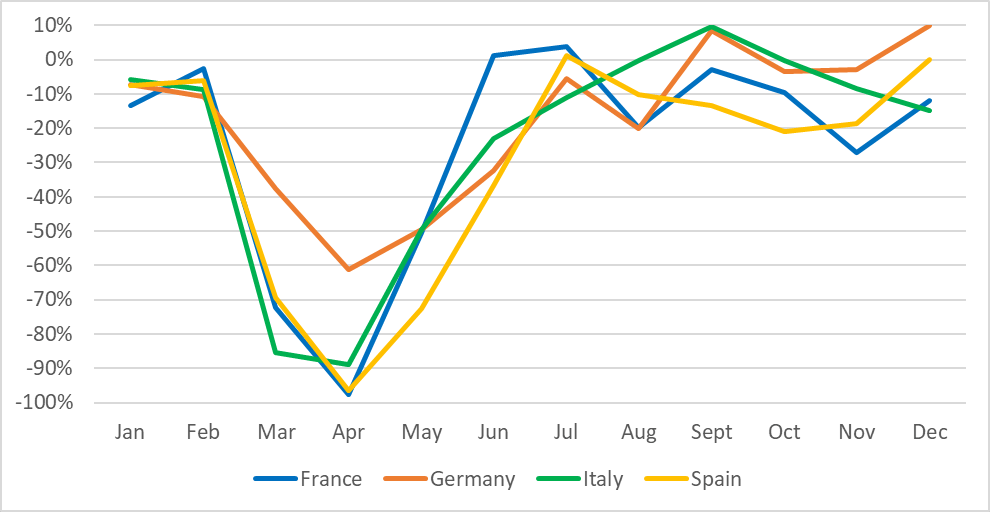
Data: CCFA, KBA, ANFIA, ANFAC
Drives and segments
With the largest share of last year’s market at 46.7%, a total of 1,361,723 petrol-powered cars were registered, down 36.3% on 2019. Meanwhile, 819,896 diesel-driven cars took a 28.1% share, down 28.9% on the previous year.
Alternative drives, consisting of hybrids, battery-electric vehicles (BEVs), hydrogen fuel-cell and gas claimed approximately a quarter of all new-car registrations in Germany last year. Hybrids achieved a share of 18.1%, up 120.6% on the previous period with 527,864 registrations, including plug-in hybrids (PHEVs) with 200,469 units, up 342.1% and with a market share of 6.9%. Electric cars represented 6.7% of the market, up 206.8% to 194,163 units. A total of 7,159 gas-powered cars were registered in 2020, down 6.1% on 2019, and LPG-driven cars saw a drop of 9.8%, to 6,543 units. CO2 emissions from cars fell by 11.0% last year, on average to 139.8g/km from 157.0g/km in the previous reporting period.
Over half of all registrations were accounted for by SUVs (21.3%), compact cars (20.5%) or small cars (15.1%). With 2.6% of the market, motorhomes saw the most significant increase, up 41.4%.
Brand performance
All German brands showed a decline last year. Smart took the hardest fall at 67.3%, followed by Opel, which dropped by 32.3%, then Ford down 30.6%. VW fell by 21.3% on the previous reporting year, Audi slumped by 19.9%, Porsche was down by 16.3%, BMW dropped by 13.7%. Negative results were also reported by Mini (down 11.7%) and Mercedes (down 10.6%). With a share of 18%, VW held the largest share of the new-car market in 2020.
For imported brands, both Tesla (up 55.9%) and Fiat (up 0.2%) reported positive results for 2020. Meanwhile, declines were recorded by Suzuki (down 44.8%), Ssangyoung (down 40.2%), Mazda (down 38.1%) and Dacia (down 36.6%). Skoda led the imported brands with a market share of 6.2%, followed by Renault with 4.3%.
Alternative drives made up a quarter of German registrations in 2020
Alternative drives, consisting of hybrid, fuel-cell, gas, hydrogen, and battery-electric vehicles (BEVs), claimed approximately a quarter of all new-car registrations in Germany in 2020. This result came in a year defined by COVID-19, when registrations in the country declined by roughly 20%.
The country’s government sought to use the pandemic as a springboard for a greener economy, with a greater emphasis on electromobility. In November last year, it committed a €4 billion stimulus package to the automotive sector, with funds being channelled into the adaptation of production lines and incentivising the purchase of electrically-chargeable vehicles (EVs).
An electric transformation
With the Kraftfahrt-Bundesamt (KBA) reporting the number of newly-registered BEVs increased by 206% in 2020, compared with 2019, the German automotive market does look to be on track for an electric transformation. Some 13.5% of all newly-registered passenger cars in the country now sport an electrified drivetrain, from BEVs to plug-in electric hybrids (PHEVs) and fuel-cell electric vehicles (FCEVs). The federal states of Schleswig-Holstein, Berlin and Baden-Württemberg played host to a high share of these new EV registrations last year, at over 16%.
‘E-mobility is now at the heart of mobile society. Positive user experiences, reliable technologies and a growing range of products facilitate the switch to e-mobility. With a sustained trend for registrations of vehicles with electric powertrains, around 22% in the last quarter of 2020, the government target of seven to 10 million electric vehicles registered in Germany by the year 2030 can be achieved,’ said KBA President Damm.
Segments and brands
The small-car segment was the strongest, accounting for 29.9% of registrations of new BEVs in 2020. Meanwhile, SUVs made up just under a fifth of the registration volume of new BEVs. The compact segment also reached a high share of this type, with 19.6%.
For BEVs, private registrations made up almost half of all registrations, at 48.8%. For all alternative powertrains, two-thirds were commercial (63.5%), and one third (35.4%) were private. Overall, some 63% of all new-car registrations, including petrol and diesel, were registered for commercial use in 2020.
A total of 394,940 new EVs were registered last year. VW passenger cars claimed the highest market share at 17.4%, up 608.6% compared with 2019. Meanwhile, Mercedes enjoyed a 14.9% share, up 499.8%, and Audi took 9%, up 607.9%. A total of 194,163 new BEVs were registered in the country in 2020. The VW brand claimed a 23.8% share of this volume, representing a 463.3% increase on the previous year. Renault then followed with a share of 16.2%, up 233.8%, and Tesla captured 8.6%, up 55.9%.
VW achieved the largest share of the EV parc, with 16%, pulling ahead of BMW at 12.3%, and Mercedes at 12.1%. For BEVs, VW claimed a 20.2% share, this time ahead of Renault at 18.1%, Smart at 11.6% and Tesla at 11.1%.
Around 70% of the battery-electric car parc was allocated to the small-car (33%), compact (19.6%) and mini (17.3%) segments. The stock of battery-electric passenger cars in the SUV segment, which has a high number of registrations, reached a share of 14.4%.
While the KBA has yet to confirm the total number of new-car registrations in 2020, at the end of last year Autovista Group’s Schwacke projected a recovery to just under 3.1 million in 2021. This would follow an expected registration volume of 2.9 million new cars in Germany in 2020.
Corona adé? – Ein vorsichtiger Blick ins Automobiljahr 2021
Bei aller Diskussion um Maßnahmen, Impfungen und anderer gesellschaftlicher Themen in der aktuellen Pandemiebekämpfung, fällt in der Branche der Jahresrückblick meist etwas milder aus als zwischenzeitlich befürchtet. Zeit, einen vagen und etwas ungewissen ersten Blick ins nächste Jahr zu werfen.
Für das Jahr 2021 erwarten wir nach einem voraussichtlichen 2020er Ergebnis von knapp 2,9 Mio. PKW-Neuzulassungen eine Erholung auf knapp 3,1 Mio. Im Positiven dürften die wiedergewonnenen Produktionskapazitäten als auch die deutlich geringeren Mengen an sehr jungen Gebrauchten aus dem ablaufenden Jahr zu Buche schlagen.
Die in 2020 notwendige Substitution des produktionsbedingten Neuwagenmangels, wird dabei zunehmend verschwinden, aber in manchen Fällen eben immer noch lieferzeitbedingt stattfinden. Aber auch die geringeren Mengen an volumenstarken Neuerscheinungen in 2021 und die Ausdünnung der Angebotspalette, aufgrund von drohenden CO2-Strafzahlungen finden ihren Niederschlag. Insgesamt haben wir auch eine etwas gedämpfte Erwartung an die gesamtwirtschaftliche Entwicklung, die die private Kaufkraft und den Investitionswillen von gewerblichen Neuwagenkunden schmälern wird. Einige negative Auswirkungen der Pandemie auf die Binnenwirtschaft werden wir zeitverzögert eben erst im kommenden Jahr erleben.
Damit wird das Neuzulassungsergebnis in unseren Augen unter den Vorjahren und sehr deutlich unter dem Spitzenjahr 2019 liegen. 2019 war allerdings auch ein Jahr, das vor allem in gewerblichen und taktischen Zulassungen gewachsen ist, was letztendlich in erster Linie das zukünftige Gebrauchtwagenangebot erhöht, aber angesichts des kaum gewachsenen privaten Neuwagensektors keine bedarfsgesteuerte Entwicklung darstellt. Glück im Unglück, dass dieses Jahr die Neuwagenproduktion eingeschränkt war und diesen Mehrvolumen ein Ventil verschafft hat.
Bemerkenswert für alle war die Entwicklung der Neuzulassungen nach Treibstoffarten. Ein prämienbedingter immenser Schub bei Plug-Ins und vollelektrischen Modellen und heftige Einbußen an Verbrennern (Abb. 1). Neuwagen-Nachfrage ist insbesondere bei Plug-In Hybriden künstlich geschaffen worden, der der Bedarf am Gebrauchtwagenmarkt noch stark hinterherhinkt.
Für die Besitzumschreibungen erwarten wir ebenfalls eine leichte Verbesserung gegenüber dem Ausgang dieses Jahres. Das Gebrauchtwagengeschäft war im ablaufenden Jahr unter den gegebenen Umständen durchaus erfolgreich und wird bis Jahreswechsel wohl knapp über 7 Millionen PKW umgesetzt haben. In 2021 rechnen wir wieder mit etwa 7 Millionen PKW, also unter den Jahren 2017-2019, da zum einen die Flottenzulassungen aus den rückliegenden relevanten Jahren 2017/2018 etwas rückläufig waren und zudem fast 400.000 taktische Zulassungen aus 2020 fehlen, die üblicherweise zu zwei Dritteln im Jahr nach Zulassung als junge Gebrauchte an Endkunden verkauft werden. Angesichts einer zu erwartenden stabilen Nachfrage durchaus ein Pluspunkt für die Preisentwicklung im kommenden Jahr, aber die Angebotsmenge wird vermutlich schlichtweg fehlen.
Insgesamt besteht aber aus Restwertsicht für 2021 ein nicht zu unterschätzendes Risiko für junge gebrauchte Plug-In Hybride und Elektrofahrzeuge, die nun in großer Stückzahl aus taktischen Zulassungen dieses Jahres vermarktet werden müssen und mangels Kaufanreiz unter Volumen- und Preisdruck geraten werden. Verbrenner haben sich wertseitig auf niedrigem Niveau stabilisiert mit leichter Aufwärtstendenz für Diesel.
Die neue Kfz-Steuerberechnung ab Januar wird aufgrund ihrer immer noch vergleichsweise geringen finanziellen Konsequenz dabei kaum steuernde Wirkung haben. Vergleicht man beispielsweise selbst für wahre „CO2-Schleudern“ die Steuer bei einer Zulassung vor und nach dem 1. Januar 2021 kommt man auf Mehrkosten von selten nennenswert zweistelligen Euro-Beträgen im Monat.
Natürlich setzen wir bei unseren Annahmen voraus, dass das Jahr pandemisch einen optimistischen Verlauf nimmt und keine schwerwiegenden Einflüsse den Markt treffen.
Hoffen und Bangen, eine Kombination, die nach nun mehreren Branchenkrisen als Fazit unter vielen Jahresrückblicken und –ausblicken hätte stehen können.
2021 bietet aber vor allem Chancen. Egal, ob durch bessere Krisenvorbereitung, neue und digitale Geschäftsmodelle, verändertes Käuferverhalten oder zusätzlichen Dienstleistungsbedarf. Gute Konzepte setzen sich auch in schwierigen Zeiten durch.
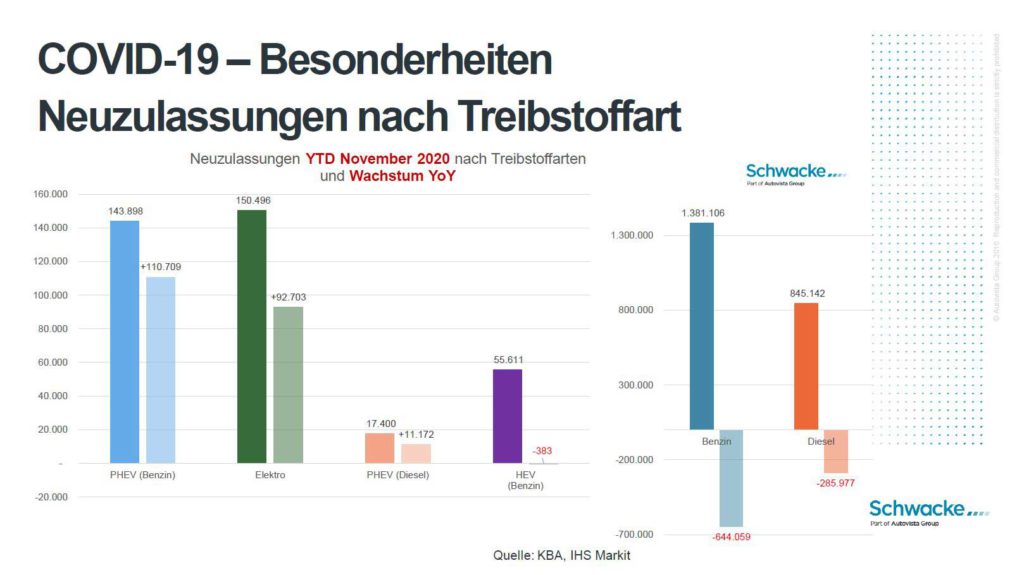
European Commission’s sustainable mobility strategy far from reality, says ACEA
The European Commission has drawn back the curtain on its Sustainable and Smart Mobility Strategy, with an action plan of 82 initiatives that will direct transport policy in Europe. It sets out how the EU’s transportation network can achieve its green and digital transformation, resulting in a 90% cut in emissions within the next 30 years. These new initiatives will set the standard over the next four years, with additional industry targets set for 2030, 2035 and 2050.
While the automotive sector has recognised the need to boost the uptake of zero-emission vehicles, the European Automobile Manufacturers’ Association (ACEA) has warned that some of the Commission’s ambitions could be a stretch. It explains the industry already dedicates much of its yearly €60.9 billion research and development budget to decarbonisation, as electromobility and digitisation shape a cleaner future.
Sustainable milestones
By providing clear milestones, the European Commission hopes to keep the transport system’s journey towards a smart and sustainable future on track. This includes ensuring there are at least 30 million zero-emission cars in operation by 2030, as well as the large-scale deployment of automated mobility, and climate neutrality in 100 European cities.
By 2050, the Commission wants nearly all cars, vans, busses and new heavy goods vehicles to be zero emission. It also expects there to be a fully-operational, multimodal Trans-European Transport Network (TEN-T) for sustainable and smart transport with high-speed connectivity.
‘To reach our climate targets, emissions from the transport sector must get on a clear downward trend,’ said Frans Timmermans, executive vice-president for the European Green Deal. ‘Today’s strategy will shift the way people and goods move across Europe and make it easy to combine different modes of transport in a single journey. We’ve set ambitious targets for the entire transport system to ensure a sustainable, smart, and resilient return from the COVID-19 crisis.’
82 initiatives
To achieve these goals, the Commission’s strategy outlines 82 initiatives within 10 key areas for action. So, for transport to become more sustainable, practical measures will need to be taken. This includes boosting the uptake of zero-emission vehicles, which can be targeted by installing three million public charging points and 1,000 hydrogen filling stations by 2030. The strategy also outlines the need to make urban mobility healthy and sustainable, for instance, by doubling high-speed rail traffic and developing extra cycling infrastructure over the next decade.
In terms of smart innovations, the Commission wants to see more connected and automated mobility, like allowing freight to seamlessly switch between transport modes. The strategy also plans on boosting the use of data and artificial intelligence, which could include supporting the deployment of drones and unmanned aircraft.
Reality check
Taking note of the Sustainable and Smart Mobility Strategy, ACEA acknowledged the objective of boosting the uptake of zero-emission cars. However, it warned the ambition to have 30 million of them across European roads by 2030 could be unrealistic. ‘Unfortunately, this vision is far removed from today’s reality,’ cautioned ACEA director-general, Eric-Mark Huitema.
New research by the association points out that of the 243 million passenger cars on the road in Europe last year, less than 615,000 fell into the zero-emission category, making up less than 0.25% of the whole car fleet. ‘To meet the Commission’s objective, we would need to see an almost 50-fold increase in zero-emission cars in circulation on our roads in just 10 years,’ Huitema explained.
He went on to say that despite industry investment and a growing market share, not all the right conditions were in place yet to take such a massive leap, such as the availability of charging points. ‘The European Commission should match its level of ambition for rolling out infrastructure across the EU with its ambition for reducing CO2 emissions from vehicles. It is quite simple: the higher the climate targets become, the higher targets for charging points and refuelling stations should be. Unfortunately, we still see a mismatch between these two elements at EU level,’ he warned.
A recent report by ACEA identifies the need for the deployment of 15 times more infrastructure over the next 11 years to meet the Commission’s target of three million public charging points, up from 200,000 last year. The association is therefore calling again for an urgent review of the Alternative Fuels Infrastructure Directive, to push national governments to invest.
‘Experience has shown us that a voluntary approach to these infrastructure targets does not work,’ stated Huitema. ‘While some EU countries have been very active, others have done little or nothing. The AFID review really must include binding infrastructure targets for member states.’
Apart from infrastructure, ACEA also identified other necessary measures to encourage consumers to make the switch to zero-emission mobility. This included the need for more aggressive carbon pricing, the continuation of fleet renewal schemes, as well as the re-training of sector workers.
Schwacke Insights Dezember 2020 – monatliche Kennzahlen im Überblick
Der Jahresausklang sieht aus der Vorkrisenperspektive nicht so schlecht aus, wie man im März erwartet haben mag. Das Niveau ist jedoch deutlich unter Vorjahr. Mengen wachsen langsam wieder an, weil Verkäufe leicht zurückgehen, während der Nachschub weiter fließt. Standzeiten der Verkauften sind auf erfreulich niedrigem Niveau, allerdings stagnieren die Werte für den Angebotsbestand, was für „Stehenbleiber“ spricht. Insgesamt dürfte der Bestand mittleren Alters am Jahresende ungefähr auf Vorjahresniveau liegen. Aufgrund des guten Verkaufs und geringem Nachschub sind die Jüngeren aber seltener als Weihnachten 2019. Insgesamt stehen also knapp 100.000 Gebrauchte weniger im Netz, was dem 2021er-Start geringeren Preisdruck verleiht. Bei den Schnelldrehern erfreuen sich in diesem Alterssegment zunehmend die 2017 neu zugelaufenen Sechszylinder Diesel des GLC großer Beliebtheit.
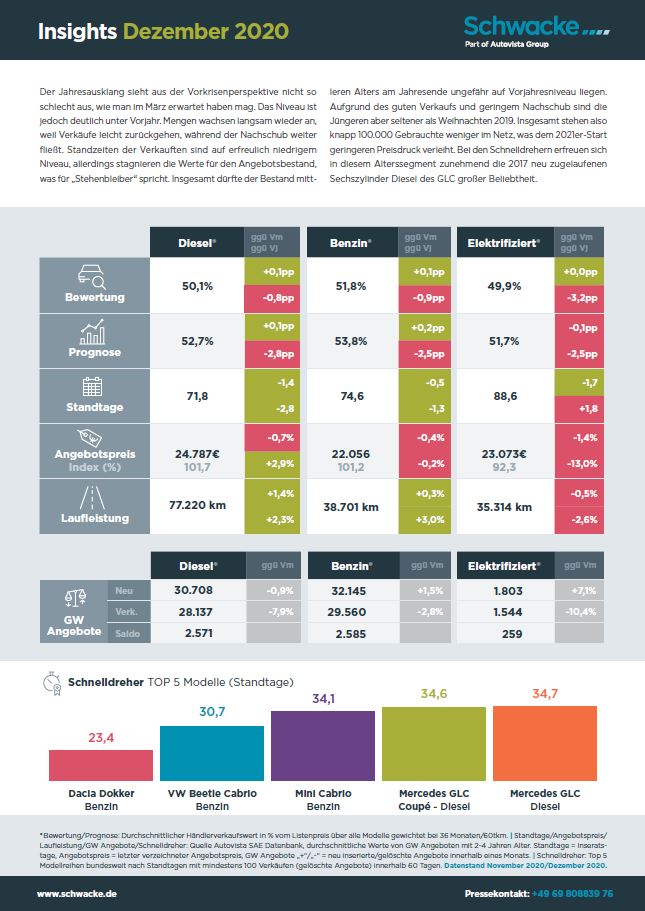
Launch Report: Hyundai i20 – sportier and more attractive
The third-generation Hyundai i20 has a stronger, sportier, and more attractive design, with tight lines and a prominent rear-quarter window, reveals the latest model launch report from Autovista Group. The model is longer and wider, which translates into more interior roominess and a 352-litre boot, which is among the largest in the B-segment.
The level of standard equipment is high and so the i20 has a very limited number of individual options available. This makes it easy for customers to configure vehicles and leads to many well-equipped used cars. The digital instrument cluster and central touchscreen in particular support the attractiveness of the interior, and strike a good balance between too many buttons and too few.
The report notes that the engine offer is rather limited, with only two petrol engines and no diesel, electric or full-hybrid versions. There is a mild-hybrid (MHEV) version but this has a battery in the spare-wheel well, reducing the boot volume to 262 litres.
The B-segment is very competitive and the i20 faces strong rivals, such as the Opel/Vauxhall Corsa, Renault Clio, SEAT Ibiza and VW Polo. Given that the segment is mainly driven by price considerations, the list prices of the i20 are rather high. In Spain for example, the price of the i20 version under review is in line with the Corsa and Polo, but it is more expensive than the best-selling SEAT Ibiza.
Nevertheless, in Germany, the i20 has recently won AutoBild magazine’s ‘Goldenes Lenkrad 2020’ – a popular reader’s choice award – in the category for cars with a list price below €25,000.
Click here or on the image below to read Autovista Group’s benchmarking of the Hyundai i20 in France, Germany and Spain. The interactive launch report presents new prices, forecast residual values and SWOT (strengths, weaknesses, opportunities and threats) analysis.


 Schließen
Schließen